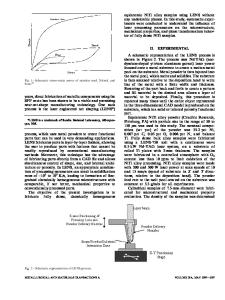Processing and Characterization of Cu-Al-Ni Shape Memory Alloy Strips Prepared from Prealloyed Powder by Hot Densificati
- PDF / 1,070,024 Bytes
- 12 Pages / 593.972 x 792 pts Page_size
- 70 Downloads / 300 Views
N
SHAPE memory alloys (SMAs) are an exquisite class of active materials with the ability to restore their original shape when placed at a higher critical temperature in deformed condition. Furthermore, SMAs were shown to possess high actuation energy densities along with the ability to absorb and dissipate mechanical energy under an applied mechanical cyclic loading. These unique characteristics of SMAs made them suitable for actuation and sensing, impact absorption, and vibration damping applications. SMAs have found applications in a variety of areas including automotive, aerospace, and biomedical applications.[1–5] At present, Ni-Ti–based SMAs are frequently used for most of the practical applications. However, Ni-Ti alloys are unsuitable for relatively high-temperature applications, especially above 373 K (100 °C). In recent years, copper-based SMAs have been considered a potential material for a variety of applications, such as high S.K. VAJPAI, Research Scholar, and R.K. DUBE and S. SANGAL, Professors, are with the Department of Materials Science and Engineering, Indian Institute of Technology, Kanpur, Uttar Pradesh, India – 208016. Contact e-mail: Email: [email protected] Manuscript submitted January 28, 2011. Article published online May 19, 2011 3178—VOLUME 42A, OCTOBER 2011
damping capacity material, sensors, and actuators.[2–5] Particularly, Cu-Al-Ni alloys have received a great deal of attention for high-temperature applications due to their high thermal stability at elevated temperatures, i.e., above 473 K (200 °C).[4–8] However, brittleness is a severe problem in the Cu-Al-Ni alloys prepared by the conventional casting method, due to large grain sizes (up to several millimeters) coupled with large elastic anisotropy.[8–10] To eradicate the problem of brittleness and to enhance ductility of conventionally cast Cu-Al-Ni alloys, several attempts were made through grain refining by addition of a fourth element, such as Ti, Zr, Mn, B, Y, V, and rare earths.[11–18] The grain refinement via alloying additions improved the mechanical properties of the Cu-Al-Ni alloys considerably, while achieving grain size in the range of 15 to 40 lm. However, subsequent annealing triggered rapid grain growth leading to a most stable structure with 200- to 300-lm grain size. Nevertheless, grain size refinement exhibited significant improvement in the mechanical properties of conventionally cast Cu-Al-Ni alloys. However, the mechanical properties of these alloys were still unsatisfactory for most practical applications. Therefore, a different processing approach is required to prepare Cu-Al-Ni alloys with more stable fine-grained structure. METALLURGICAL AND MATERIALS TRANSACTIONS A
The powder metallurgy (PM) route has been traditionally considered a way to produce fine-grained material with improved mechanical properties. Additionally, the PM route provides a much better control over composition and grain size. However, the consolidation of powders to prepare useful products, such as strip, rod, and wire, with near-full density is t
Data Loading...











